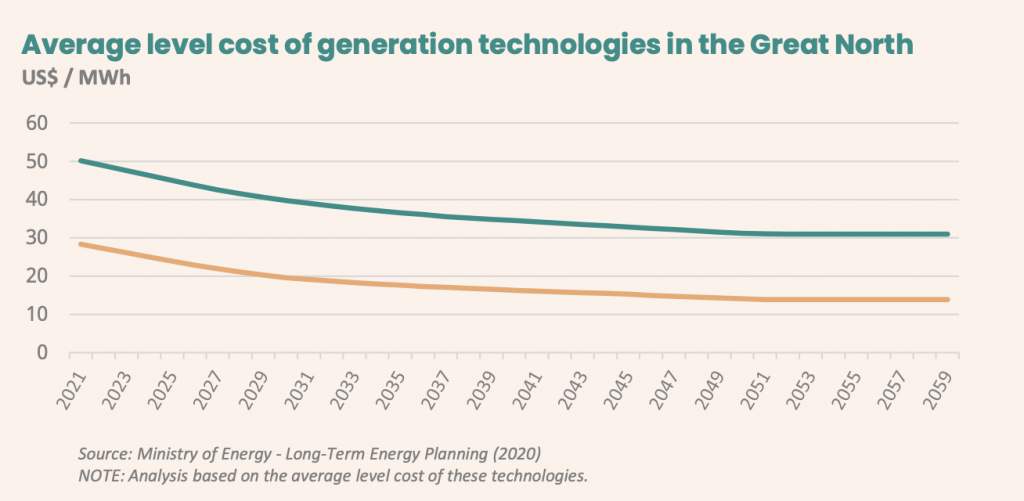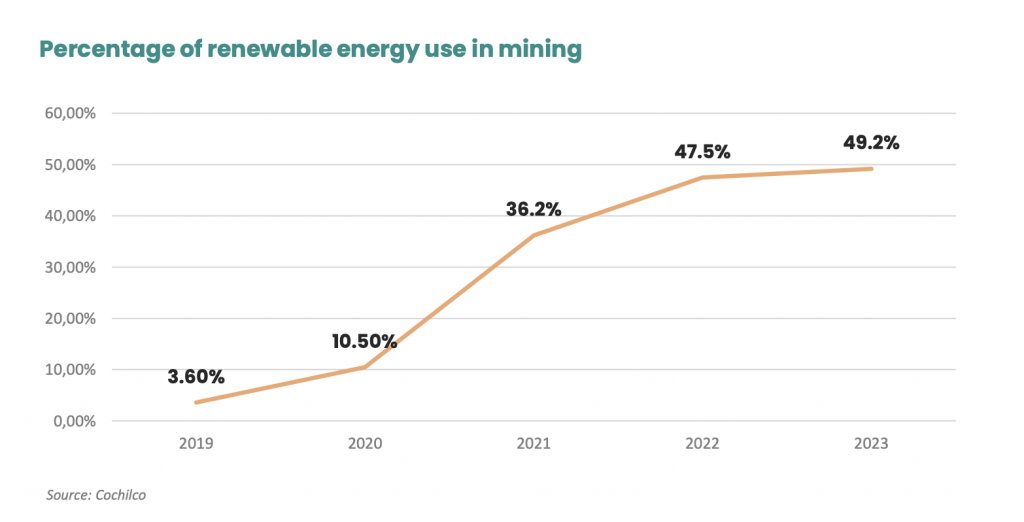Growth of Renewables in the Chilean Mining Industry
Chile has lots of copper, but it has never been well endowed with carbon-based fuels. With limited gas and oil production, Chile relied on imports from neighboring countries to fuel its energy needs. The energy matrix was mainly made up of coal, diesel, and LNG.
The warning bells started ringing in 2014 when the Chilean energy market was reaching its breaking point. At the time, the government regulators warned that the country needed to urgently ramp up its installed power capacity by 18,000 gigawatts to meet the future demand of miners. In addition, the mining sectors energy operating costs represented roughly 14% of total production costs, equivalent to 27% per pound of metal, the highest level since 2000.
Chilean miners had watched their energy prices climb 11% over a decade leading up to 2014, some were paying twice as much for their energy as their peers in neighboring Peru. There were concerns from the mining industry that energy prices would affect future investment.
That was the start of the Chile’s energy transformation…
Chile’s Energy Transformation
Since 2015, Chile has dramatically increased its solar and wind capacity year over year. It has done so without any major government subsidies which is a major accomplishment.
One of the reasons is that the country is blessed with the Atacama Desert in the north, where the average solar irradiation is approximately double the average irradiation in Spain. In addition to this, the timing of Chile renewable growth fit well with the overall decrease in costs for solar panels and wind turbines during the same period.
The result has been that renewables contributed on average over 25% to the national grid in 2021. This has risen since then with a wave of new project built and now sits over 30% for 2022. The new National Energy Policy is even more ambitious with aims to reach 80% by 2030; and 100% by 2050. Goals that many experts believe are possible.
Prices have dropped steadily since Chile has started the transformation. Solar energy produced in Northern Antofagasta region is expected to fall from a current average of US$25/MWh to about US$10/MWh in 2050. Wind energy costs are projected to drop from around US$23/MWh to US$20/MWh by mid-century.

The country won’t stop there. Chile’s energy ministry has unveiled a national green hydrogen strategy that aims to turn the country into a world-class producer and exporter by 2040. Chile will do this by leveraging the low cost of its renewable energy. The country has potential to generate over 1,800GW of renewable capacity, approx. 70 times the country’s current demand.
The roadmap to development will come in three stages, with the first would focus on large-scale domestic consumption through existing demand, for example in refineries. The second stage would spread hydrogen use to the transport sector and exports. The third stage would involve large-scale deployment of export infrastructure.
Chile’s Mining Industry
The mining industry is one of Chile’s top carbon emitters but it has also been the countries best adopter of renewables. Some could argue that if it was not for the mining companies’ willingness to sign power purchase agreements, then many renewable projects would have not been able to finance themselves in the early days.
Currently, 16 mining companies have signed clean energy supply contracts, while four have their own non-conventional renewables projects.
In 2019, the percentage of the use of renewable energies in mining was 3.60%; in 2020 it made a great leap, reaching 10.50%, while 2021 marked a milestone, with 36.20%. This year it is expected to reach 47.50%.

According to the National Mining Policy 2050, it is estimated that the use of renewable energies in mining will reach 49.20% by 2030. At the current growth, the industry should pass this goal by a long shot.
Major mining companies in Chile have set carbon emissions reduction goals for the next decade to contribute to Chile’s efforts to be carbon neutral by 2050. The 13 companies who have set targets account for 97% of the copper produced in Chile. For example, Anglo American seeks to be carbon neutral by 2040 while BHP plans to be so in 2050. Codelco is aiming for a 70% reduction in emissions by 2030 compared with 2020.
It has not been just large miners, small to medium size miners have also been making efforts as is the case of Enami and Cerro Negro.
Where is the Mining Industry to go now?
In order to cut emission further, mining companies will need to look at electrifying their fleets and reducing the carbon footprint in their supply chains. Green hydrogen is an important part of miners plans to reduce carbon emissions in their operations.
Using green hydrogen to fuel haulage trucks will be a huge step for miners to improve their carbon efforts. There is said to be around 1,500 haul trucks operating in Chile. Each day, a truck needs around 3,500l of diesel, consuming the energy 700kg of hydrogen could provide.
Green hydrogen could also substitute natural gas in the fire refining step during primary copper production, when most of the oxygen is removed from the blister copper before it is cast into anode. This will require further technical research, but it is another place the hydrogen could help mining companies reduce their carbon footprint.
Government promotion agency, CORFO is already supporting three hydrogen-related projects involving the transformation of diesel trucks, the use of hydrogen cells in underground mines, and the design and construction of a hybrid engine prototype with hydrogen-based batteries and cells to be used also in mining trucks.
Although Chile has done a terrific job of growing its overall renewable production and having the mining industry lead the way, there are some challenges that still need to be solved.
- The country has faced a drought which has severally reduced its capability to produce hydroelectricity.
- Photovoltaic solar plants in the north have not been able to inject electricity into the system at its maximum potential, due to the lack of transmission capacity that brings it to the central region of the country.
- The slow expansion of transmission infrastructure has caused delays in projects in the past and could slow down the rate of expansion soon.
- The intimacy of renewables and the closure of coal fired plants means that the country needs to ensure there is a stable base load of energy. This will be done through batteries which is only now starting to pick up steam but its only one part of the solution.
- Chile has been slow to build out other sources of clean energy. The most abundant being geothermal which could provide base power to the system when wind and solar production is at its lowest.
Conclusion
The Chilean mining industry has an important role in the global economy as countries look to reduce their carbon footprint. As a key supplier of critical minerals such as copper and lithium, the sustainability aspects of the mining industry will increasingly become non-negotiable. The energy matrix is only one part of ensuring operations are sustainable.
Mining suppliers will play a large role helping mining companies to bridge the gap between where they are now and where they need to be. Suppliers will be needed to help reduce water usage in production processes, improve the economics for dewatering tailings, create cheaper and more efficient desalination plants, introduce less intrusive mining techniques to minimise disturbances on ecosystems, improve environmental monitoring, and to deliver products that can be recycled and reused in the circular economy.
All these challenges will open new opportunities for mining suppliers that will lead to new revenue sources and more jobs for the industry.
Ax Legal is an advisory firm that works with foreign companies in Latin America. Our team of legal and commercial advisors have a distinguished track record of helping foreign technology and services companies to grow and operate in Latin America. Over the years, we have worked with starts up, mid-size businesses, and publicly listed companies. The one common factor that connects our clients is that they are leaders in their field, providing innovative technologies and services to the industrial sectors.
To better understand how we can support you in the Region, please contact Cody Mcfarlane at cmm@ax.legal




 Santiago
Santiago Sydney
Sydney Lima
Lima